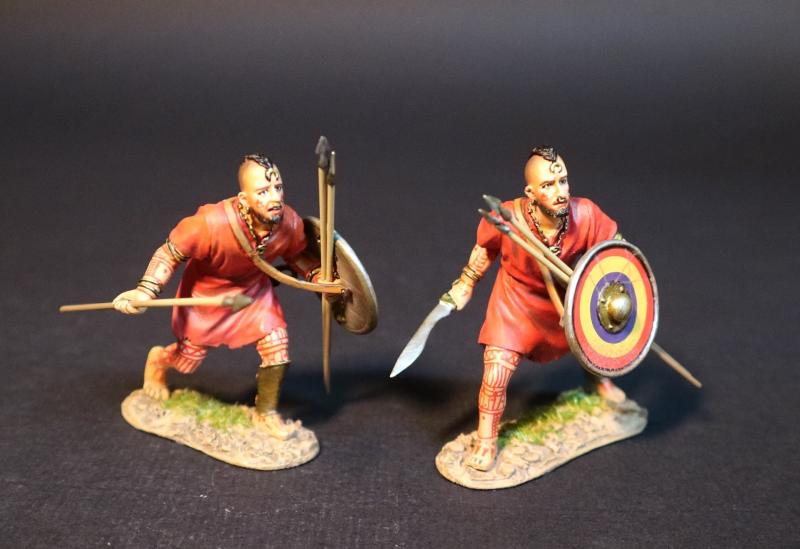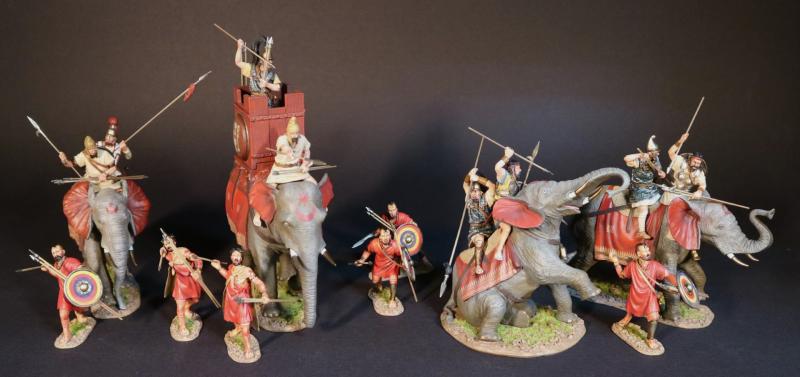Two Adyrmachid Warriors, The Carthaginians, The Battle of Zama, 202 BCE, Armies and Enemies of Ancient Rome--two figures carrying javelins and round shields (holding third javelin, wielding sword)
$98.00
Item Number: CTSK-02
Two Adyrmachid Warriors, The Carthaginians, The Battle of Zama, 202 BCE, Armies and Enemies of Ancient Rome--two figures carrying javelins and round shields (holding third javelin, wielding sword)
ARMIES AND ENEMIES OF ANCIENT ROME
THE CARTHAGINIANS
THE BATTLE OF ZAMA, 202 BCE
Carthage learnt the use of elephants from fighting in Sicily against Pyrrhus of Epirus between 278 and 276 BCE. The Carthaginians quickly realized they could easily acquire African Forest Elephants which inhabited North Africa in great numbers. It was much easier to capture these elephants than import elephants from India.
It was not long before Carthage had the most powerful elephant corps in the Mediterranean world, with stables housing up to 300 elephants located in the capital. They would replace chariots as the Carthaginian’s main striking force.
The elephants primarily used by the Carthaginian armies were of the now extinct smaller African kind. They stood between 2m and 2.5m tall. These elephants were taken from the now long vanished forests of Numidia. Their primary use was to terrify the uninitiated man and horse, and they carried a single rider known as a mahout, who was armed with a javelin. Each elephant could also carry an additional soldier armed with javelins or a long spear.
It is believed that the elephants deployed at Zama did not carry infantry in howdahs on their backs. Most scholars doubt it as the forest species being smaller than Asian elephants, it is believed could not carry the additional weight. Any elephants with towers were believed to have been imported from India. However, the Egyptian Ptolemies as well as Numidian kings are recorded as having put towers on forest elephants, and the Roman poet Juvenal mentions towers on Hannibal’s elephants.
In 218 BCE, the Second Punic War began and the famous Carthaginian general Hannibal traversed the Alps to invade Italy with an army that included 37 war elephants, which were believed to be mostly African. In the course of that arduous crossing, many men, cavalry and draught animals were lost, but apparently (according to ancient sources) not a single elephant. The elephants were to contribute to Hannibal’s first victory in Italy, on the Trebbia river, where they frightened the Roman cavalry and routed the Roman auxiliaries. Shortly after the battle, all but one elephant died. It is not known why? Maybe the after effects of exhaustion suffered during the crossing, or some disease incurred during the campaign, are all distinct possibilities.
NORTH AFRICAN ALLIES
Although initially the Carthaginian army was composed only of Citizens of Phoenician origin, it saw increased recruitment of contingents of mercenaries and allies a necessity in order to realize the policy of imperial expansion. This use of mercenaries saved the metropolitan population from heavy casualties that were not easily replaceable, and it also reflected the Carthaginian concept of war, which was considered simply as an extension of business. With the enlargement of Punic economic interests the army became more exclusively mercenary and progressively came to include almost all the peoples of the central and western Mediterranean area.
The largest single component of the Punic army usually comprised soldiers recruited or impressed from subject Libyans. These are often referred to as “Africans”, or Liby-Phoenicians. These were mercenaries or in some cases conscripts, subject to service from the tenants of the large African estates. Eventually these mercenaries were no longer simply troops hired for a single campaign and discharged after a few months service, as had originally been the case, especially during the first Punic War. They were now a professional standing army seasoned by long years of warfare, under the command of skilled generals such as Hamilcar Barca and his sons.
Among the North African allies were the subjected Libyans of the Marmarica, which formed a major part of the light infantry. These were mainly made up from several tribes, Nasamones, Macae from the Cynips river, the tribes of Barce, the Autololes, the ferocious Adyrmachidae, and the Garamantians.
ADYRMACHID WARRIORS
This Libyan tribe called the Adyrmachidae were described as carrying a buckler of many colours ,a sword in the shape of a sickle, and would wear a single greave on the left leg. Warriors would have their head shaved except for a central plaited crest, often with a crescent amulet fastened to hang on his brow. Nose rings were also typical for many punic cultures.
Released in AUGUST 2024.

